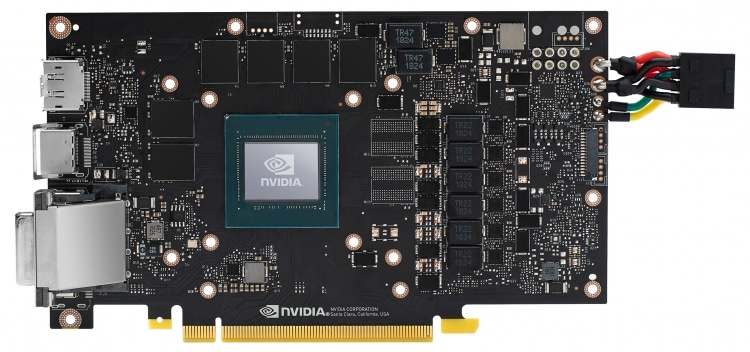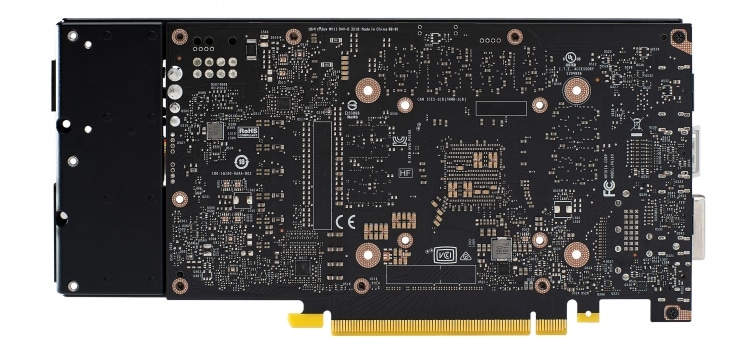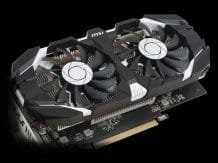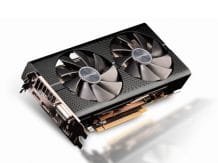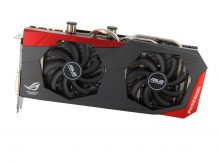Take a look at the GeForce RTX 2060, review, hash rate, profitability, specification and other vital information that you will need to make a decision.
The rumors surrounding the 60th model of the GeForce 20 series have finally vanished. This is really RTX, which means that the RT and tensor kernels from it have not gone away. Let’s see if the new rendering technologies are ready for use in mid-range accelerators.
The Turing family of GPUs that NVIDIA released four months ago has become one of the biggest events in the history of 3D graphics. For the first time, video cards for home PCs and workstations have acquired ray tracing functions in real-time. Even if only Battlefield V and the fresh 3DMark test provide an opportunity to see Ray Tracing in action, the introduction of this technology in other projects is also not far off, and in the future, it will be ray tracing that will support the development of computer games. After all, it not only provides a fundamentally different quality of lighting but also facilitates the task of developers due to the fact that those effects that require painstaking manual adjustment in the context of rasterization are now elegantly automated.
However, NVIDIA’s first experience in this area made it clear that the transition to a hybrid rendering model (as the company calls it a combination of rasterization with ray tracing) is not free. The video cards of the GeForce RTX 20 series do not differ so much from the previous generation in speed in games without ray tracing, as those, in turn, from their predecessors. At the same time, the three models presented in August ( GeForce RTX 2070, RTX 2080 and RTX 2080 Ti ) turned out to be so expensive that the GPU upgrade rule, which worked without fail earlier (more FPS for the same money), is no longer valid.
Finally, the experience of Battlefield V showed that Ray Tracing in real time is still difficult to provide even with such powerful hardware as the new accelerators based on Turing chips. Therefore, up to the moment when NVIDIA introduced the GeForce RTX 2060, it was unclear whether the company plans to extend the Turing architecture unchanged to mid-range video cards, or whether hybrid rendering will remain the privilege of devices for $ 500 and above. But doubts remained in the past, because the very name RTX 2060 suggests that green light is given to ray tracing in conventionally mass graphics cards.
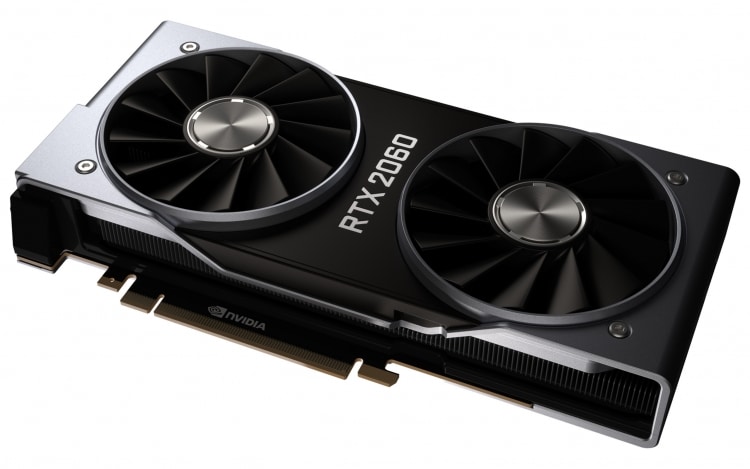
Specifications and Price
In the first wave of models of the 20th series, the GeForce RTX 2070 was the only graphics card that received a fully functional graphics processor, while the GeForce RTX 2080 and RTX 2080 Ti are built on a GPU with partially blocked computing units. The TU106 chip, which debuted with the GeForce RTX 2070, belongs to the third echelon of the Turing family and is the formal successor to the GP106, but by the standards of the previous NVIDIA architecture, Pascal is still an extremely large crystal: with a transistor budget of 10.8 billion, it is second only to GP102 (12 billion transistors) and is 50% superior to GP104. This means that the release of the next model of the GeForce RTX 20 series based on “truncated” TU106 chips was an absolutely logical step on the part of NVIDIA.
TU106 in the GeForce RTX 2060 configuration has 1920 active CUDA cores (in this case we consider only cores that perform FP32 operations) distributed across 30 stream multiprocessors (Streaming Multiprocessor, SM), while the “physically” crystal consists of 36 SM and contains 2304 CUDA kernels. NVIDIA chips, released since the Fermi architecture, allow you to scale all the main components of the hardware pipeline by disabling defective or simply “unnecessary” for a particular SM model. As a result, the GeForce RTX 2060 simultaneously lost 17% of computing power when executing 32-bit floating point operations (CUDA-FP32), integer operations (INT32 CUDA-cores) and texture blending speed. Nevertheless, the GeForce RTX 2060 has a lot left of the original power of the GeForce RTX 2070. For comparison: the GeForce GTX 1060 contains 1,
Profitability of Nvidia GeForce RTX 2060

| Manufacturer | NVIDIA | ||||||
|---|---|---|---|---|---|---|---|
| Title | GP104 | GP102 | GP100 | Gv100 | TU106 | TU104 | TU102 |
| Microarchitecture | Pascal | Pascal | Pascal | Volta | Turing | Turing | Turing |
| Process technology, nm | 16 nm FinFET | 16 nm FinFET | 16 nm FinFET | 12 nm FFN | 12 nm FFN | 12 nm FFN | 12 nm FFN |
| The number of transistors, million | 7,200 | 12,000 | 15 300 | 21 100 | 10 800 | 13,600 | 18 600 |
| Chip area, mm2 | 314 | 471 | 610 | 815 | 445 | 545 | 754 |
| SM / TPC / GPC Configuration | |||||||
| SM number | twenty | thirty | 60 | 84 | 36 | 48 | 72 |
| TPC Number | twenty | thirty | thirty | 42 | eighteen | 24 | 36 |
| GPC Number | 4 | 6 | 6 | 6 | 3 | 6 | 6 |
| Streaming Multiprocessor (SM) Configuration | |||||||
| FP32 cores | 128 | 128 | 64 | 64 | 64 | 64 | 64 |
| FP64 cores | 4 | 4 | 32 | 32 | 2 | 2 | 2 |
| INT32 kernels | N / A | N / A | N / A | 64 | 64 | 64 | 64 |
| Tensor kernels | N / A | N / A | N / A | 8 | 8 | 8 | 8 |
| RT cores | N / A | N / A | N / A | N / A | one | one | one |
| Programmable GPU Computing Units | |||||||
| FP32 cores | 2,560 | 3 840 | 3 840 | 5,376 | 2 304 | 3,072 | 4 608 |
| FP64 cores | 80 | 120 | 1 920 | 2 688 | 72 | 96 | 144 |
| INT32 kernels | N / A | N / A | N / A | 5,376 | 2 304 | 3,072 | 4 608 |
| Tensor kernels | N / A | N / A | N / A | 672 | 288 | 384 | 576 |
| RT cores | N / A | N / A | N / A | N / A | 36 | 48 | 72 |
| Fixed Function Blocks | |||||||
| TMU (texture mapping blocks) | 160 | 240 | 240 | 336 | 144 | 192 | 288 |
| Rop | 64 | 96 | 128 | 128 | 64 | 64 | 96 |
| Memory configuration | |||||||
| L1 cache / texture cache size, KB | 48 | 48 | 24 | ≤ 128 out of 128 shared with shared memory | 32/64 of 96 (shared with shared memory) | 32/64 of 96 (shared with shared memory) | 32/64 of 96 (shared with shared memory) |
| The amount of shared memory / SM, KB | 96 | 96 | 64 | ≤ 96 out of 128 (shared with L1 cache) | 32/64 of 96 (shared with L1 cache) | 32/64 of 96 (shared with L1 cache) | 32/64 of 96 (shared with L1 cache) |
| The volume of the register file / SM, KB | 256 | 256 | 256 | 256 | 256 | 256 | 256 |
| The volume of the register file / GPU, KB | 5 120 | 7 680 | 15 360 | 21 504 | 9,216 | 12,288 | 18 432 |
| L2 cache size, KB | 2,048 | 3,072 | 4,096 | 6 144 | 4,096 | 4,096 | 6 144 |
| RAM bus width, bit | 256 | 384 | 4,096 | 4,096 | 256 | 256 | 384 |
| Type of RAM chips | GDDR5 / GDDR5X | GDDR5X | HBM2 | HBM2 | Gddr6 | Gddr6 | Gddr6 |
| NVLINK bus | N / A | N / A | 4 × NVLink 1.0 x8 | 6 × NVLink 2.0 x8 | N / A | 1 × NVLink 2.0 x8 | 2 × NVLink 2.0 x8 |
The transformation of the GeForce RTX 2070 to RTX 2060 hit the part of the GPU called the back-end much harder: memory controllers, ROPs, and second-level cache size. NVIDIA disabled two of the eight 32-bit RAM controllers in the TU106, which means that the GPU now has only a 192-bit memory bus, and the GeForce RTX 2060 specifications provide 6 GB of GDDR6 type with a throughput of 14 Gbit / s per bit bus. However, there are hints that NVIDIA will not be limited to the only version of the GeForce RTX 2060 and in the future there will be configurations with a different capacity (3 or 4 GB) and the type of chip (GDDR5). And if you look at the variety of video cards GeForce GTX 1060, then the set of active computing units in the potential six (!) Versions of the GeForce RTX 2060 can also change.
In terms of frequency range of the GPU, the novelty is not too different from the GeForce RTX 2070. NVIDIA lowered the core core frequency from 1410 to 1365 MHz, while at the same time, the Boost Clock turned out to be higher compared to the reference parameters of the RTX 2070: 1680 versus 1620 MHz. A reduced set of computing units was also reflected in the TDP of the video card: the power limit of the RTX 2060 and RTX 2070 is 160 and 175 W, respectively.
| Manufacturer | |||||
|---|---|---|---|---|---|
| Model | GeForce GTX 1060 6 GB | GeForce RTX 2060 | GeForce RTX 2070 | GeForce RTX 2080 | GeForce RTX 2080 Ti |
| GPU | |||||
| Title | GP106 | TU106 | TU106 | TU104 | TU102 |
| Microarchitecture | Pascal | Turing | Turing | Turing | Turing |
| Process technology, nm | 16 nm FinFET | 12 nm FFN | 12 nm FFN | 12 nm FFN | 12 nm FFN |
| The number of transistors, million | 4400 | 10 800 | 10 800 | 13,600 | 18 600 |
| Clock, MHz: Base Clock / Boost Clock | 1506/1708 | 1365/1680 | 1 410/1 620 (Founders Edition: 1 410/1 710) | 1,515 / 1,710 (Founders Edition: 1,515/1,800) | 1,350 / 1,545 (Founders Edition: 1,350 / 1,635) |
| Number of Shader ALUs | 1280 | 1920 | 2304 | 2944 | 4352 |
| Number of texture mapping blocks | 80 | 120 | 144 | 184 | 272 |
| ROP Number | 48 | 48 | 64 | 64 | 88 |
| RAM | |||||
| Bit depth, bit | 192 | 192 | 256 | 256 | 352 |
| Chip type | GDDR5 SDRAM | GDDR6 SDRAM | GDDR6 SDRAM | GDDR6 SDRAM | GDDR6 SDRAM |
| Clock frequency, MHz (bandwidth per contact, Mbps) | 2000 (8000) 2250 (9000) | 1 750 (14 000) | 1 750 (14 000) | 1 750 (14 000) | 1 750 (14 000) |
| Volume, MB | 6 144 | 6 144 | 8 192 | 8 192 | 11,264 |
| Input / output bus | PCI Express 3.0 x16 | PCI Express 3.0 x16 | PCI Express 3.0 x16 | PCI Express 3.0 x16 | PCI Express 3.0 x16 |
| Performance | |||||
| Peak performance FP32, GFLOPS (based on maximum indicated frequency) | 4372 | 6451 | 7,465 / 7,880 (Founders Edition) | 10 069/10 598 (Founders Edition) | 13,448 / 14,231 (Founders Edition) |
| Performance FP32 / FP64 | 1/32 | 1/32 | 1/32 | 1/32 | 1/32 |
| RAM bandwidth, GB / s | 192/216 | 336 | 448 | 448 | 616 |
| Image output | |||||
| Image Output Interfaces | DL DVI-D, DisplayPort 1.3 / 1.4, HDMI 2.0b | DisplayPort 1.4a, HDMI 2.0b | DisplayPort 1.4a, HDMI 2.0b | DisplayPort 1.4a, HDMI 2.0b | DisplayPort 1.4a, HDMI 2.0b |
| TBP / TDP, W | 120 | 160 | 175/185 (Founders Edition) | 215/225 (Founders Edition) | 250/260 (Founders Edition) |
| Retail price (US, without tax), $ | 249 (recommended) / 299 (Founders Edition, nvidia.com) | 349 (recommended) / 349 (Founders Edition, nvidia.com) | 499 (recommended) / 599 (Founders Edition, nvidia.com) | 699 (recommended) / 799 (Founders Edition, nvidia.com) | 999 (recommended) / 1,199 (Founders Edition, nvidia.com) |
| Retail price (Russia), rub. | ND (recommended) / 22,990 (Founders Edition, nvidia.ru) | ND (recommended) / 31,990 (Founders Edition, nvidia.ru) | ND (recommended) / 47,990 (Founders Edition, nvidia.ru) | ND (recommended) / 63,990 (Founders Edition, nvidia.ru) | ND (recommended) / 95,990 (Founders Edition, nvidia.ru) |
The GeForce RTX 2060 is initially available in both the reference version (Founders Edition) and partner devices. Since NVIDIA started selling video cards under the Founders Edition brand name on its own, the company has been striving to distance them from the concept of a reference model. But the GeForce RTX 2060 FE is appropriate to call just that – after all, this time NVIDIA did without factory overclocking the video card, and the price of the Founders Edition does not differ from the recommended one.
With regard to market positioning, the GeForce RTX 2060 continues the policy set by the older models of the 20th series: at a price of $ 349, the new product corresponds to the previous generation model, which stood one step higher in the GeForce 10 family – GTX 1070, while GeForce The GTX 1060 was once released at a suggested price of $ 249. From AMD, the closest rival to the GeForce RTX 2060 will be the Radeon RX Vega 56, whose recommended price is $ 399. It is difficult to predict which of the two video cards will be the winner of today’s test: on the one hand, Vega 56 even at the time of its release, when games for Direct3D 11 prevailed, and AMD drivers were not as optimized as they are now, it easily outperformed the GeForce GTX 1070 in speed . On the other hand,
Construction
Since the GeForce RTX 2060 is built on the same GPU as the GeForce RTX 2070, NVIDIA did not design a separate printed circuit board and cooling system for the new model of the 20th series, but completely copied the snap-in of the device introduced in August. Given that we still have not had the opportunity to study the GeForce RTX 2070, this is our first look at the design of the younger Turing family accelerators under the brand name Founders Edition.
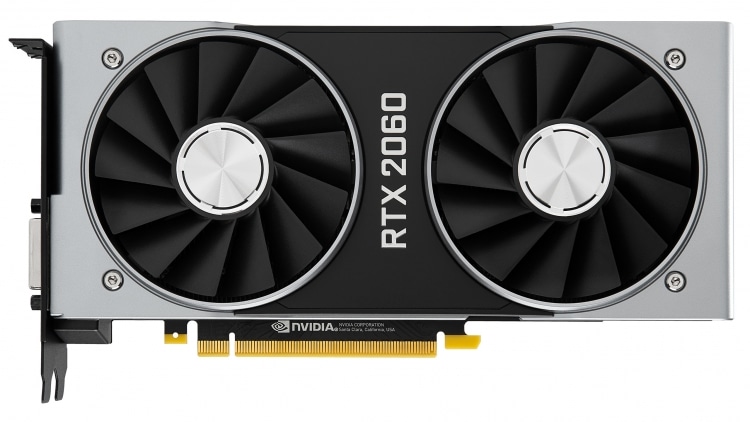
The GeForce RTX 2060 and 2070 Founders Edition are tailored to the same patterns as the RTX 2080 and RTX 2080 Ti. In the past, reference versions of the top GeForce were equipped with closed cooling systems with a centrifugal fan. The “turbine” design is good in that it throws out heated air outside the PC and does not depend so much on the ventilation inside the case as its open counterparts. But an example of the GeForce GTX 1080 Ti showed that a centrifugal cooler cannot effectively cool video cards with a power reserve of 250 W and higher, while maintaining a comfortable noise level, so NVIDIA engineers created an open cooling system for the GeForce RTX 2080 and RTX 2080 Ti, and thanks to the evaporative camera at the base of the radiator, very effective for its small dimensions.
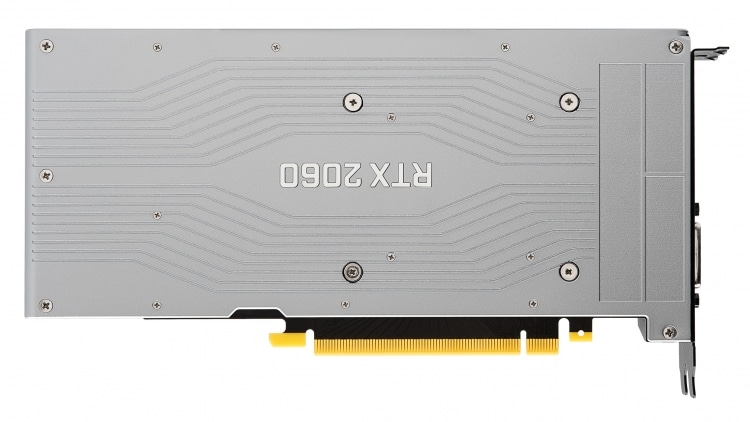
The GeForce RTX 2060 and RTX 2070 have significantly lower heat dissipation (160 and 185 W in Founders Edition versions) and could well get along with the standard “turbine”. But since the CO of the new sample copes well with the heat dissipation from the TU104 and TU102 chips, the younger Turing chip under the same cooler will be comfortable anyway.
The dimensions of the GeForce RTX 2060 FE are significantly smaller than the older models, but there are a number of other differences. Like the RTX 2070, the video card lacks the NVLink interface, and the DVI-D output takes the place of one of the DisplayPort sockets: since adapters of this class are not designed to play at resolutions higher than 1440p, they can still be used in conjunction with old monitors. At the same time, NVIDIA retained the USB Type-C connector, which allows you to connect the video card to the VR helmet using the DisplayLink protocol or connect any peripherals to the PC with a data transfer rate of up to 10 Gb / s.
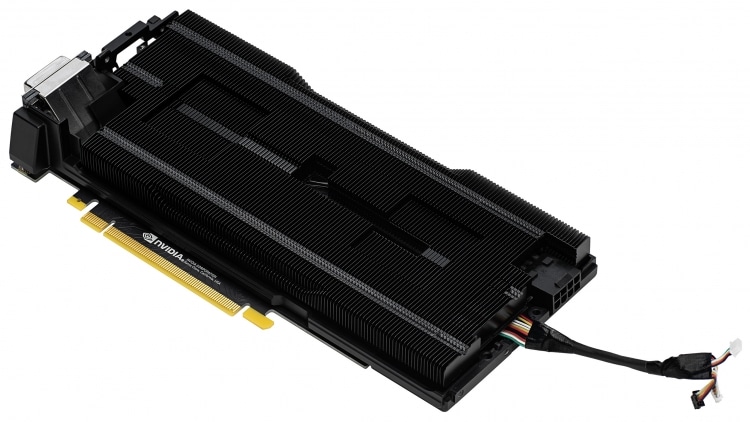
The casing of the cooling system, made of thick aluminum plates, surrounds the inside of the video card on three sides and allows two fans with a diameter of 85 mm to drive air along the short side of the circuit board. The radiator fills all the free space inside the casing, but its design is significantly simplified compared to the GeForce RTX 2080 and RTX 2080 Ti and resembles reference video cards of the GeForce 10 family. The evaporation chamber no longer covers the entire area of the printed circuit board and is pressed only to the GPU chip, but the heat distribution along the fins of the radiator is facilitated by a flat thermotube. Other components requiring active cooling are covered with a separate metal frame.
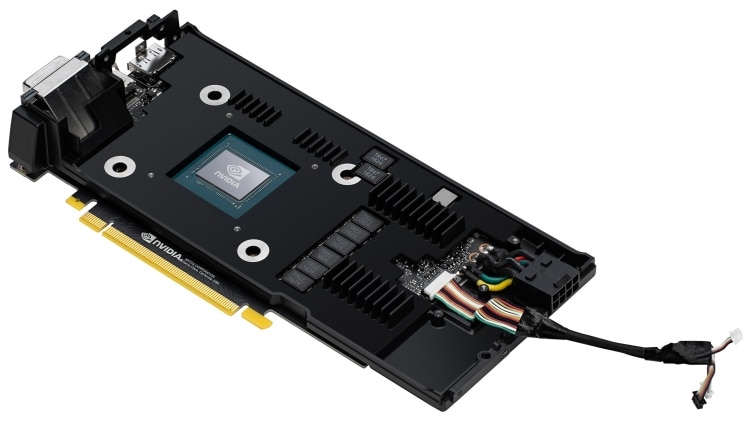
Printed circuit board
The GeForce RTX 2070 circuit board has moved to a younger model with minimal changes. NVIDIA removed two of the eight GDDR6 chips, but all components of the voltage regulator remained intact. VRM contains six phases for powering the GPU and two for RAM chips. UPI uP9512 PWM controller in combination with DrMOS microcircuits (field effect transistor with integrated driver) provides high-frequency and accurate monitoring of the voltage at the transistor drain by the IMON signal and allows you to dynamically adjust the number of active phases in order to maintain high efficiency in the entire range of power consumption.
The graphics card receives additional power through a single eight-pin connector. If you take into account the power lines of the PCI Express slot, the rated power of the device can reach 225 W, but the wiring of the connector suggests that the GeForce RTX 2060 FE is not prepared for serious overclocking. Here’s the thing: the Founders Edition printed circuit board is shorter than the cooling system, and so that the power supply cable can be connected from the end of the case, the connector is connected to the PCB by an intermediate cable, with the plus and ground lines assembled in two bundles, each of which sealed in one hole (the yellow and green wires are used by some power supplies to control the voltage, but in most cases they work as additional ground). We saw the same design in the reference version of the GeForce GTX 1060. It’s unlikely that the GeForce RTX 2060 FE will threaten anything even with moderate overclocking of the GPU,
